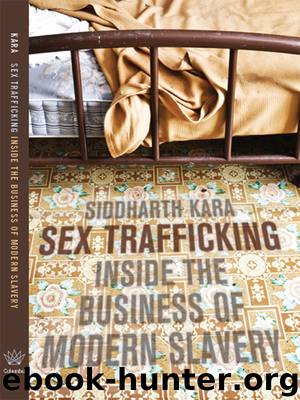Sex Trafficking by Siddharth Kara

Author:Siddharth Kara
Language: eng
Format: epub
Tags: Law/Criminal Law
Publisher: Columbia University Press
Published: 2011-12-23T16:00:00+00:00
Vlora
Throughout the 1990s, Albania was the chief transit country for slave trading from Eastern Europe to Italy and from Italy to the remainder of Western Europe. Though several international organizations and the U.S. government have stated that this is no longer the case,8 my experiences in a town called Vlora led me to conclude otherwise.
Getting to Vlora was not easy. The night before I was supposed to travel, I suffered an asthma attack. I had been struggling to breathe since I arrived in Albania due to the country's shockingly filthy air. During my plane's descent into Tirana, I saw a broad stream of mist flowing over sharply folded mountains, only to discern a few moments later that the mist was actually smoke rising from immense fires burning on a mountainside. Friends had warned me that Albania was a heavily polluted country; the warnings were an understatement. Tirana was blanketed in a brown haze that left me coughing and rubbing my eyes for my entire visit. Dust from construction, a high density of poorly maintained vehicles, and a lack of winter rain left Tirana choked with debris. The absence of rain had another negative effect: The country was almost out of electricity. Albania's energy resources were almost entirely hydroelectric, and as weeks passed without rainfall, rolling blackouts of up to ten hours were the norm in every city I visited. My taxi driver from Rinas Airport summed up the situation as only a local could. “Albania must have rains!” he said. “In Tirana, very dirty. In Tirana, no electricity. Electricity caput. Catastrophe!”
My first stop in Vlora was the Vatra Psycho-Social Center, the first shelter created for trafficking victims in Albania. The shelter was founded in 1998 by Vera Leskaj, a dedicated anti-trafficking crusader who had to flee Vlora more than once under threat from the Albanian mafia. Two of Vera's right-hand women, Donika Curraj and Brikena Puka, shared years of insight into the trafficking situation in Albania and the use of Vlora's harbor as a launch point for Western Europe. They told me that, from the early 1990s until a police crackdown called Operation Puna in 2002, Vlora was an oceanic superhighway of slave trading via speedboats into Italy. During this time, speedboats brimming with women and children raced in broad daylight across the sea to Italy several times a day, making the journey in as little as two hours. Up to two thousand people were trafficked each month. Drugs and illegal weapons were included in the shipments, which were controlled by the Albanian mafia. If the Italian coast guard approached the speedboats, “the traffickers would throw a girl overboard so the authorities must stop to help her, and the speedboat would escape,” Ms. Curraj told me. She also said that Romanians, Moldovans, Russians, Bosnians, Montenegrans, and Ukrainians were heavily trafficked into Albania specifically to transport them from Vlora to Italy. Slave traders entered Albania with relative ease across its remote and mountainous land borders with Serbia and Montenegro, Kosovo, and Macedonia.
Download
This site does not store any files on its server. We only index and link to content provided by other sites. Please contact the content providers to delete copyright contents if any and email us, we'll remove relevant links or contents immediately.
| General | Discrimination & Racism |
Nudge - Improving Decisions about Health, Wealth, and Happiness by Thaler Sunstein(7622)
iGen by Jean M. Twenge(5367)
The Fire Next Time by James Baldwin(5250)
Adulting by Kelly Williams Brown(4488)
The Hacking of the American Mind by Robert H. Lustig(4319)
The Sports Rules Book by Human Kinetics(4297)
The Ethical Slut by Janet W. Hardy(4177)
Captivate by Vanessa Van Edwards(3796)
Mummy Knew by Lisa James(3635)
In a Sunburned Country by Bill Bryson(3486)
The Worm at the Core by Sheldon Solomon(3436)
Ants Among Elephants by Sujatha Gidla(3417)
The 48 laws of power by Robert Greene & Joost Elffers(3029)
Suicide: A Study in Sociology by Emile Durkheim(2975)
The Slow Fix: Solve Problems, Work Smarter, and Live Better In a World Addicted to Speed by Carl Honore(2949)
Humans of New York by Brandon Stanton(2835)
The Tipping Point by Malcolm Gladwell(2829)
Handbook of Forensic Sociology and Psychology by Stephen J. Morewitz & Mark L. Goldstein(2660)
The Happy Hooker by Xaviera Hollander(2655)
